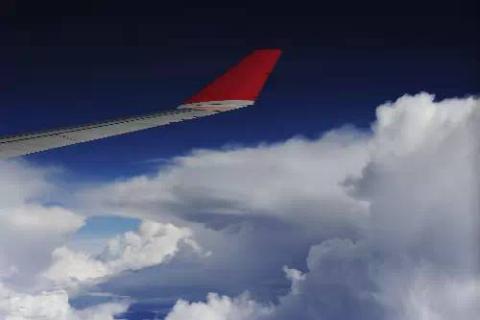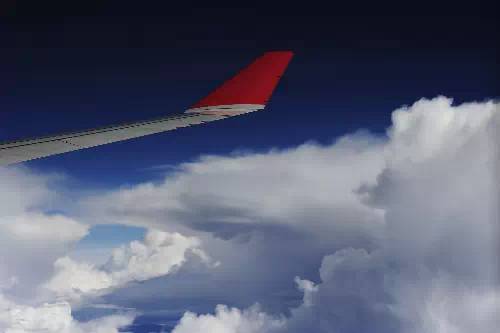
DAY1:Chengdu-Lhasa (offline)
"Dad, why do you like Tibet so much?" my daughter asked on the plane flying to Lhasa. I looked out the window at the almost unreal blue sky and didn't answer. Maybe I was also thinking about this question, maybe I wanted her to Take this trip to find out for yourself. It is true that this is my fourth time in Tibet, but I am still as excited as the first time. Maybe I have a connection with Tibet in my previous life, where I will hear my own heartbeat and always forget all my impetuousness and worries.
The red color on the wing was very eye-catching against the sky, and we finally set off again.

In midsummer in August, the snowy peaks are looming in the clouds, and the altitude must be above 5,000 meters.

Gem-like seas are scattered among the mountains.

Like the eyes of the earth.

It was the first time for my daughter to travel to Tibet. Adaptation to high altitude sickness was very important for the rest of the trip. After arriving at the hotel in Lhasa, she lay down on the bed to rest. After dinner, we took a slow walk to Bu Palace Square.

The observation deck of Yaowang Mountain was crowded with all kinds of guns, mobile phones and IPADs. I raised the sensitivity of FUJIFILM X100S and opened the aperture to 2.0, and squeezed in the crowd to take pictures of Potala at night. Ask the security guard about the opening time here tomorrow morning and continue walking back to the hotel to sleep.

DAY2:Recuperate and adapt in Lhasa, visit Bu Palace, and pray at Barkhor Street
Before dawn, on the viewing platform of Yaowang Mountain, several "masters" from all over the world and I had already set up our cameras and waited for the sunrise at the Bu Palace. After the rain, the Beijing Road was glowing with charming light under the street lights. .

Looking at the gloomy sky, the sunrise at the Bu Palace seemed to be in vain, but no one left, waiting for the sky to slowly light up. I really liked the tranquility of Lhasa in the early morning.

Raindrops began to fall from the sky again, several "masters" were busy putting away their cameras, and early risers began to meditate along the outer prayer path of the Bu Palace.

I went back to the hotel and woke my daughter up. The high fever she had yesterday had disappeared, and she seemed to be adapting well. After breakfast, we went straight to Barkhor Street to see the herdsmen doing their morning prayers. The Jokhang Temple is the center of Tibetan Buddhism. Barkhor Street is the outer sutra path surrounding the Jokhang Temple. There is also an inner sutra path inside the Jokhang Temple, which is the most sacred in the eyes of Tibetans. Staff are cleaning the butter lamp room. These butter lamps are offered by people who come to worship. Each lamp represents a prayer.

Herdsmen who came to worship the Jokhang Temple lined up in a long line on Barkhor Street early. Unlike tourists, they did not need to buy tickets, but they had to queue for a long time to enter the temple.

The child on its mother's back looks curiously at my camera.

Two little girls in the group whispered secrets between them.

The little boy lining up with his mother had questions in his eyes.

The dogs on Barkhor Street were very leisurely and carefree. Later, they were like this in many places. I was very envious of them.

A girl kowtowing while turning around Barkhor Street caught my eye.

She covered her face with the gauntlet board.

Every movement he made was pious, and he also watched every move I made.

I don’t want to offend this piety, nor am I curious, but I am deeply moved by this piety!

Several old people resting on the street corner

The old man turning his head and looking back in front of the prayer flag tower

Every time they walked around, they would kowtow at the entrance of the Jokhang Temple.

Or lean your forehead against the prayer flag tower to make a prayer.

All the faces are filled with devotion to Buddha.

After walking around Barkhor Street with my daughter, it was still early before the appointment time to visit the Bu Palace, so we went to the nearby Guangming Port Qiongtian Teahouse to rest. This sweet tea house is very famous in Lhasa, especially Lhasa people like it very much. As long as you put a handful of change on the table, you can drink authentic Tibetan sweet tea.

Guangminggang Qiongtian Tea House is different from another Canggu Temple Sweet Tea House that I like. You can smoke and play cards here and it has a stronger market flavor.

But here you can feel the purest Lhasa life.


There are also some Tibetan beauties

Nowadays, tickets to the Bu Palace may be the most difficult to buy in Lhasa. Not only do you need to make an appointment and register with your real name, but you also have to queue up one hour before the appointment time, because there is a daily limit of 4,000 people entering. If you miss the time, even if you have an appointment ticket, you will not be able to buy it. Can't get in. Taking the Bu Palace as the starting point is to let my daughter start to understand the history of Tibet.
The Potala Palace was built in the 7th century AD during the reign of King Songtsen Gampo of Tibet and has a history of 1,300 years. In the early 7th century AD, after Songtsen Gampo moved the capital to Lhasa, in order to marry Princess Wencheng of the Tang Dynasty, he built three nine-story buildings with a total of one thousand palaces on the Red Mountain, named the Potala Palace. According to historical records, there is a silver-bronze bridge connecting Songtsen Gampo and Princess Wencheng's palace on the third level of the inner and outer city of Hongshan. There is Songtsen Gampo's racecourse outside the east gate of the Potala Palace. When the Tibetan dynasty established by Songtsen Gampo was destroyed, most of the Potala Palace was destroyed by war. The current appearance of the Potala Palace is mainly the White House rebuilt during the period of the fifth Dalai Lama in the 17th century AD and the Red Palace built after his death. Since then, successive Dalai Lamas have successively expanded it, eventually reaching the scale of the Potala Palace today.
As the center of political and religious unity in Tibet, the Bu Palace plays an important role in Tibet. In 1690, under the auspices of Dipa Sangye Gyatso, the Red Hall of the Fifth Dalai Lama Pagoda was modified and completed in 1693. Later it experienced expansion on behalf of the Dalai Lama. For more than 300 years, the Potala Palace has collected and preserved extremely rich historical relics. Among them are more than 2,500 square meters of murals, nearly a thousand pagodas, tens of thousands of statues, and tens of thousands of thangkas; there are also precious scriptures and classics such as the Bayeux Sutra and the Kangyur Sutra; they represent the history of Tibetan local government and The emperors of the Ming and Qing dynasties, who were affiliated with the central government, bestowed gold volumes, gold seals, and jade seals on the Dalai Lama, as well as a large number of gold and silver products, porcelain, enamelware, jades, brocade forgings, and craft treasures. These cultural relics are colorful and rich in themes.
Of course, there are many stories that happened in Bu Palace. After the death of the fifth Dalai Lama, Dipa Sangji Gyatso deliberately concealed it and secretly searched for the reincarnated soul boy of the fifth Dalai Lama in Qiongji County, Shannan and sent him to a temple for training. Later, Emperor Kangxi discovered that this young man was sent to the Bu Palace, which symbolizes the pinnacle of political and religious power in Tibet, without knowing it, and became the puppet of Dibasangji Gyatso. This young man had no interest in politics and power. This young man had no interest in politics and power. For him, the palace was like a cage. This cage deprived him of his love and freedom, but could not deprive him of his talent in poetry. He was the sixth Dalai Lama, Tsangyang Gyatso.

Photography is not allowed in the Bu Palace. It is indeed an excellent place to study the history of Tibet. If there are not many tourists, you can calm down and slowly appreciate the history and stories accumulated here. But it’s impossible now, because even if you don’t want to leave, the tourists behind you will push you forward. Fortunately, my daughter made preparations in advance.
After visiting the Bu Palace, it was still early. After sending my daughter back to the hotel to rest, I went to the Jokhang Temple alone. This is indeed my favorite place.

In the afternoon, there were far fewer herdsmen kowtowing at the entrance of the Jokhang Temple.

But you can still capture unforgettable moments, because these moments have a soul, and this soul is faith.




I kept taking pictures until the sun's shadow became longer and longer, and I walked back to the hotel while taking pictures along Barkhor Street.


There are many tourists walking on the prayer path together, but the differences among tourists are so obvious.

We rushed back to the hotel to pick up the car from a friend. Tomorrow we will drive to Shannan to explore the origin of Tibet.
